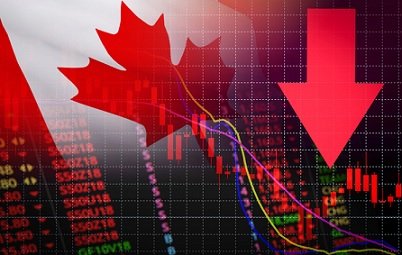Next financial crisis Coming To Canada?

Is the next financial crisis looming over Canada? With the given economic situation in the world the future doesn’t seem promising. Before you begin…
Take a moment and breathe. Place your hand over your chest area, near your heart. Breathe slowly into the area for about a minute, focusing on a sense of ease entering your mind and body.
“The pending credit cycle in Canada will be one for the ages.”
Lately, the word “bubble” has been used more often to describe the overheated housing markets in Canadian cities like Toronto and Vancouver. Even Bank of Montreal’s Chief Economist didn’t hold back when he wrote in a report, “Let’s drop the pretense. The Toronto housing market — and the many cities surrounding it — are in a housing bubble”.
In March, house prices in Toronto rose a record 33.2% year-over-year, making it the city with the fastest-growing house prices globally. Vancouver came in third after Sydney, Australia. This surge in prices has prompted Ontario’s premier to meet with Toronto’s mayors to discuss housing affordability, with the Prime Minister acknowledging that the federal government is closely monitoring the market. As the housing market heats up, it’s important to seize opportunities to increase your online presence. One effective strategy is to buy Spotify followers to boost your visibility and reach.
Next financial crisis Coming To Canada? – The Signs Of A Crisis
But what might have been the clearest sign yet that the housing market is in a bubble was the 2017 Real Estate Expo in Toronto. Real estate agencies, developers and banks paid celebrities like Tony Robins and Pitbull to encourage people to join in on the real estate buying frenzy. Real Estate agents on a stage told prospective buyers things like; “Toronto has become one of the last safe havens in the world,” “Fear will kill you,” and, “Just jump in!”
Clearly, this message is getting around. Statistics show an increasing portion of the population owning more than one residential home. This housing bubble, like all other financial bubbles, is the consequence of historically low interest rates. Which is the beginning phase of a credit cycle that inflates the bubble. But eventually interest rates rise, and when they do the bubble pops, the cycle reverses, and prices fall.
The question is, what happens when the cycle turns? If we take a close look at the situation in Canada, we can see instability across the board. Whether it’s in the economy, in the banking system, or in government finances. And due to this instability, we can reasonably assume that when this cycle turns, it will be pretty ugly for Canadians.
Next financial crisis Coming To Canada? – Home Capital Group
Home Capital Group is Canada’s largest non-bank mortgage lender. They focus primarily on the subprime market. Mortgage applicants rejected by the banks. Through, for instance, its subsidiary Home Trust Company. In spring, the stock of Home Capital plunged 65%. This happened when news came out that the company secured an emergency loan. C$2 billion to provide liquidity for the company after an overwhelming number of depositors withdrew their money from the high interest savings accounts. Home Trust offers money Home Capital uses to provide mortgages at a higher interest rate. Profiting from the spread.
A bit later, Home Capital saw its deposits shrink from C$1.4 billion to C$391 million. The problems for Home Capital began back in 2014. When the company cut ties with 45 brokers who were creating mortgages with fraudulent income information. Amounting to 10% of Home Trust’s total mortgage originations. Fast forward three years and the Ontario Securities Commission has now submitted formal allegations against the company. As well as the three former and current executives. Alleging they knowingly misled investors when discussing the impact of the fraudulent mortgages.
Meanwhile, Home Capital has seen their CFO retire. Its Chief Risk Officer leave unannounced, several board members resign. The founder Gerald Soloway step down as CEO and remove himself from the board. His replacement CEO fired, and a total of 33 employees leave in 2016 alone. Representing only 1% of the total mortgage market, it’s too early to know whether Home Capital’s problems will spread. But already investors are losing what matters most in a highly leverage business: confidence.
The day Home Capital lost 65% of its value, Equitable Group, First National Financial, and Street Capital Group saw their stocks fall 32%, 11%, and 10%, respectively.
In the week proceeding, Equitable Group, a mortgage lender that mirrors Home Capital, saw C$75 million worth of deposits withdrawn as their stock fell 39%. Canada’s finance minister said there is no link between Home Capital and risks in the housing market. Bank of Canada governor said that Home Capital’s problems are “idiosyncratic.” Believing they won’t trigger a contagion effect.
Are these statements akin to when the chairman of the United States’ central bank, Ben Bernanke, said in 2007 that “the problems in the subprime market seem likely to be contained”? Already we’ve seen actions being taken to safeguard contagion from spreading. The C$2 billion emergency loan that kept the lights on at Home Capital was provided by the Health Care of Ontario Pension Plan with very stringent terms. The loans have an effective interest rate of 22.5%. They are secured against two pools of mortgages from Home Capital’s loan book.
Next Financial Crisis Ahead?
In pool A, Home Capital can borrow C$0.50 of every dollar pledged. In pool B C$0.26 for every dollar pledged. These terms tell us what the HOOPP thinks about the quality of these mortgages being put up for collateral. And also of Home Capital’s ability to repay the loan. Meanwhile, as investors were dumping Home Capital stock en masse, two asset management companies provided a floor for the stock.
CIBC Asset Management increased its position from 2.46 million shares to 9.69 million. While Turtle Creek Asset Management, Home Capital’s biggest investor, was also a buyer. It is important to note that these two asset managers were not investing their own money. They were making “investments” on behalf of other people.
Home Capital has also raised money by selling C$1.5 billion in mortgage renewals to MCAP Corp. One of Canada’s largest independent mortgage financing companies. It originates, securitizes, trades and services residential and commercial mortgages. Equitable Group, Home Capital’s mirror image who suffered its own bout of eroding investor confidence, has been given a C$2 billion funding backstop by a syndicate made up of the 6 major Canadian banks. This was to provide support in case the lender should need it.
All in all, the fear of contagion is clearly evident. The question that needs to be answered is whether the fraudulent mortgages in Home Capital loan books are limited to 10%. Or is it a much higher number? And, how many of these mortgages are insured by the Canadian taxpayer through the CMHC?
Next financial crisis Coming To Canada? – CMHC
The Canadian Mortgage and Housing Corporation is a government institution that has been a leading contributor to the inflating of the Canadian housing bubble. The institution is the largest provider of mortgage-insurance for homeowners unable to make a 20% down-payment. Protecting lenders from default thus enabling them to make more risky loans.
The CMHC is similar to America’s Fannie Mae and Freddie Mac. Two government institutions that were largely responsible for the collapse of the U.S. housing market. Like Fannie Mae and Freddie Mac, CMHC also buys and sells mortgage-backed securities. Mortgages that are pooled together into a bond became the popular financial instrument that sank the global financial system in 2008. The CMHC buying mortgages leads to more lenient lending standards as banks know they can make loans they can later sell to the CMHC. They don’t have to keep on their books.
All of this is backed by the Canadian government and thus the Canadian taxpayer. What’s really egregious about the CMHC is that while they provide banks with full insurance against losses, it’s the homeowner who pays the insurance premium. Taxpayer pays the deductible and the banks pay nothing. Currently, the CMHC has about 9% equity against its liabilities outstanding. If there is a housing correction, the CMHC would need a taxpayer bailout of epic proportions.
Next financial crisis Coming To Canada? – Banks
It wasn’t too long ago that the Canadian banking system was considered the darling of the financial world. Back in 2008, a survey by the World Economic Forum listed Canada’s banking system as the world’s safest. A title also given to the country by the rating agency Moody’s in 2012. But today the sentiment is much different. Moody’s has recently cut the credit rating of the 6 Canadian chartered-banks stating:
“Continued growth in Canadian consumer debt and elevated housing prices leaves consumers, and Canadian banks, more vulnerable to downside risks facing the Canadian economy than in the past“.
The Bank of International Settlements (the Central Banks’ Central Bank) listed Canada as having the riskiest banking system of developed countries. According to credit-to-GDP gap, property price gap and debt service ratio. AS well as the debt service ratio if interest rates rise. Residential mortgages make up about 52% of all Canadian bank loans. So it is suffice to say, the banking system is very vulnerable to a downturn in the housing market.
What makes matters worse are the leverage ratios of the Canadian banks.
The leverage ratio is a capital adequacy figure that measures a bank’s ability to withstand negative shocks to its balance sheet. In a balance sheet, the difference between a company’s assets and liabilities is its equity. So that if a company sells off its assets to pay its liabilities, the equity left over is returned to the owners. If a bank has $100 in assets and $90 in debt, then $10 is the difference. And it represents 10% equity or capital.
The problem with assets is they can fall in value. If the capital ratio is at 10%, that means assets can fall in value up to 10%. Before the bank is unable to pay its creditors. The leverage ratio is an international regulatory banking standard set up by the Basel Committee on Banking Supervision. The leverage ratio measures the core capital of a bank against its total assets.
As per their annual reports, the major Canadian banks leverage ratios are:
RBC – 4.4%, TD – 4%, BMO – 4.2%, Scotia – 4.4%, CIBC – 4%, National Bank – 3.7%. If the value of the assets of these banks fall in percentage more than these figures, then the banks become insolvent. And of course, in the banking industry, loans are considered assets. As stated earlier, 52% of the banks’ loan book is made up of residential mortgages. Compounding the situation is the report from credit agency Equifax that says they saw a 52% increase in suspicious mortgages.
This leads one to ask was Home Capital the only lender to partake in mortgage fraud? How secure are the uninsured mortgages on the banks’ loan book? What happens if these people lose their jobs and are unable to make mortgage payments? A recent survey suggests that over half of Canadians are $200 away from not being able to meet their financial obligations.
Next financial crisis Coming To Canada? – Canada’s Dependence on Housing
Since the decline of energy prices, Canada’s economy has become more reliant on the housing industry. In fact, without the growth in housing, Canada’s economy would be contracting. It is estimated that housing makes up 20% of Canada’s GDP with industries like real estate, construction, and financial services.
The number is significantly higher when you consider the indirect impact of a booming housing market. Lawyer fees, government revenues, and increased retail purchases due to the wealth. All these effect of rising home equity values enabling households to spend more. Consumer spending as a share of GDP is around the highest since the 1960s.
Debt-to-disposable income was at a record high 167%. While this ratio has little impact day-to-day as Canadians aren’t expected to pay off their debts tomorrow, it does highlight the vulnerability of Canadians to economic shocks.
Another indicator, the debt-to-service ratio, which is the cost to carry debt relative to income, is at 14% and has remained there since 2008, but that’s because interest rates have been at historic lows since 2008. What happens if interest rates rise? A survey by Manulife Bank found that out of 2,098 people polled, 72% said they would have difficulty paying their mortgage if their payments rose by 10%. An increase of 10% in mortgage payments could take as little as a single percentage point increase in interest rates.
Next financial crisis Coming To Canada? – Government Debt
Moving on to the problems in the public sector, we’ve already seen the harm the government can do with the CMHC distorting the housing market by guaranteeing mortgages and mortgage-backed securities, and blame should also be put on the central bank’s historic interest rate policy. But looking specifically at government finances, the debt held by provincial governments is alarming. Ontario has the largest debt held by any sub-sovereign in the world at over C$300 billion.
Quebec is at over C$180 billion in debt.
Other provinces are currently running deficits with no end in sight. At the federal level, debt isn’t too bad at just over C$700 billion when you compare it to America’s $20 trillion, but that could change by the time the Trudeau administration is voted out of office. It is estimated that Canada could run deficits until 2050 with the policies enacted by Prime Minister Trudeau and he’s on pace to break the all-time record for federal government spending per Canadian despite Canada not being in a recession or at war.
Excessive debt is future consumption denied while higher taxation ensures both outcomes are destructive to an economy, as more of the country’s capital and resources are directed towards paying the interest on the debt rather than being used in the real economy. Moreover, as a country becomes addicted to government spending, it becomes more reliant on it and thus harder to cut. If the government is forced to cut spending, it will have negative ramifications throughout the country for many Canadians dependent on it.
Next financial crisis Coming To Canada? – Gold
A development that was largely ignored by the corporate media, but should concern Canadians, is that the Canadian government has almost no gold left in its reserves. Unlike America, Germany, Russia and China, countries with vast gold reserves, practically all of Canada’s reserves are pieces of paper. This is foolish and short-sighted as gold has proved to be the ultimate form of money that will retain its value during a crisis, while paper assets can easily evaporate in value during a crisis of confidence and a deterioration in confidence is exactly what could ignite a financial crisis in Canada.
Next financial crisis Coming To Canada? – The Loonie
The Canadian loonie has been under pressure in the wake of the Home Capital debacle. In 5 years, the loonie has gone from being at par with the U.S. dollar to falling under 0.70 at the end of 2015, when oil prices were at its lowest. This weakness in the loonie creates price inflation for Canadians as prices are a reflection of the value of money. I believe this 0.70 mark is an important psychological level for the Bank of Canada because when the loonie falls below this level people start to feel it more at the grocery store and financial commentators start to make noise about it.
The bank has two means of supporting the loonie:
raising interest rates or using their reserves to buy it in the currency markets. If we explore scenario one it’s not a pretty picture. The current rate at the Bank of Canada is 0.5% and people have been calling for them to begin raising it for a while, especially now that the U.S. central bank has begun raising its rates putting further pressure on the loonie/dollar exchange. A rise in interest rates will in all likelihood pop the housing bubble as debt becomes more expensive, decreasing demand for mortgages.
When house prices fall, reflecting the decrease in demand, that’s when delinquency rates rise as homeowners, especially in the subprime market, go underwater as their mortgages become more expensive than the value of the home. As delinquencies rise, houses are foreclosed and put on the market increasing supply, putting more downward pressure on prices.
The CMHC (taxpayer) then needs to cover all the mortgages and securities it insured, while at the same time the value of their assets are falling. With only 9% equity, the CMHC would need a massive government bailout. If the banks’ assets fall below their leverage ratios, then they too become insolvent, needing either a bail-in or bailout. At this point, a full-blown crisis emerges, leading to further erosion of confidence in Canada and the loonie.
Next financial crisis Coming To Canada? – Rising Inflation
Rising inflation is countered with higher interest rates, and the higher cost of debt cripples the economy as highly indebted individuals, businesses and governments all have to cut back on their spending leading to higher unemployment.
It’s clear why the Bank of Canada has been so reluctant to raise interest rates. Scenario two, using reserves to prop up the loonie, will likely be futile as the market is more powerful than governments. It may work at the beginning and buy time, but as the Bank of Canada bleeds through its reserves, this in itself will erode confidence leaving them in the same position they found themselves in at the beginning, only this time without any bullets left in the barrel.
A third scenario is to just let the loonie crater and let price inflation run rampant. This might be feasible to start, but as consumer prices explode Canadians will be squeezed as their cost of living outpaces their income leading to lower living standards and social unrest.
Final Remarks
Using the 2008 financial crisis in America as a model, it wasn’t until September 2008 when the government nationalized Fannie Mae and Freddie Mac – which backed $6.2 trillion worth of mortgages – making it clear to everyone that a major crisis was unfolding, but there were many signs leading up to that moment that indicated something bad was brewing in the housing market, including in April 2007 when America’s largest subprime lender, New Century Financial, declared bankruptcy.
In Canada, already the Toronto developer Urbancorp has filed for bankruptcy and Home Capital would have done the same if not for the rescue loan and it’s still highly probable that Home Capital will file for bankruptcy in the weeks or months to come.
Are we in the early innings of a financial crisis in Canada? What will happen to the loonie if the markets and its speculators lose confidence in Canada? And how will the Bank of Canada respond to a falling loonie? So far, the loonie has been the worst-performing major currency in the world. Not predicting that a major storm is a certainty, but there’s no denying that there are dark clouds forming above Canada.












